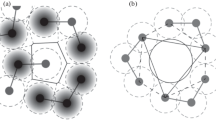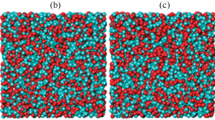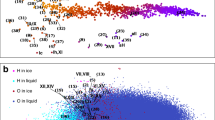Conclusions
By finding a F-structure corresponding to a certain instantaneous configuration (I-structure), it becomes possible to examine pairs of molecules and determine which of them form hydrogen bonds, even in the case of pairs of molecules for which it would otherwise be difficult to say whether or not they participate in hydrogen bonding. In the F-structure obtained for water, less than 10% of the hydroxyl groups do not participate in hydrogen bonds, and three-quarters of the molecules are tetrahedrally coordinated. The hydrogen bond criterion based on binding F-structures (i. e., on a search for the closest local mininum in the potential energy) that is used in modeling by the Monte Carlo method can be likened in some degree to a previously proposed dynamic criterion applied in molecular-dynamic modeling [26]. Both criteria take into account not only the instantaneous state, but also the “fate” of a particular pair at the closest moment of time (molecular dynamics) or after a lowering of the temperature (Monte Carlo). Of course, in order to reveal the fundamental relationships in liquid structure, it is necessary to obtain a representative set of F-structures [30], which requires major expenditures of machine time.
Similar content being viewed by others
Literature Cited
P. M. Zorkii, in: Physical Chemistry — Current Problems [in Russian], Ya. M. Kolotyrkin, ed., Khimiya, Moscow (1982), pp. 134–179.
G. G. Malenkov, in: Physical Chemistry — Current Problems [in Russian], Ya. M. Kolotyrkin, ed., Khimiya, Moscow (1984), pp. 41–76.
A. K. Lyashchenko, Zh. Strukt. Khim.,9, No. 5, 781–787 (1968).
A. K. Lyashchenko, in: Physical Chemistry of Solutions [in Russian], O. Ya. Samoilov, ed., Nauka, Moscow (1972), pp. 5–12.
G. G. Malenkov, Zh. Strukt. Khim.,7, No. 3, 331–336 (1966).
I. Z. Fisher, Statistical Theory of Liquids, University of Chicago Press (1964).
D. Eisenberg and W. Kauzmann, Structure and Properties of Water, Oxford University Press (1969).
G. G. Malenkov, in: The Chemical Physics of Solvation, Part A, R. Dogonadze et al., eds., Elsevier, New York (1985), pp. 355–389.
Yu. I. Naberukhin, Zh. Strukt. Khim.,25, No. 2, 62–80 (1981).
Yu. I. Naberukhin, Zh. Strukt. Khim.,25, No. 2, 60–66 (1984).
G. G. Malenkov, Zh. Strukt. Khim.,25, No. 2, 67–69 (1984).
Yu. I. Naberukhin, V. P. Voloshin, and N. N. Medvedev, Rasplavy,1, No. 2, 71–77 (1987).
F. Hirata and P. J. Rossky, J. Chem. Phys.,74, 6867–6874 (1981).
A. C. Belch, S. A. Rice, and M. G. Sceats, Chem. Phys. Lett.,77, 455–459 (1981).
D. A. Zichi and P. J. Rosky, J. Chem. Phys.,83, 797–804 (1985).
N. P. Malomuzh and I. Z. Fisher, Zh. Strukt. Khim.,14, No. 6, 1105–1106 (1973).
F. H. Stillinger and T. A. Weber, J. Phys. Chem.,87, 2833–2840 (1983).
F. H. Stillinger and T. A. Weber, Phys. Rev. A.,25, 978–989 (1982).
F. H. Stillinger and T. A. Weber, J. Chem. Phys.,80, 4434–4437 (1984).
T. A. Weber and F. H. stillinger, J. Chem. Phys.,80, 2742–2746 (1984).
V. I. Poltev, A. V. Teplukhin, N. V. Shulyupina, and G. G. Malenkov, Mol. Biol.,21, No. 6, 1600–1609 (1987).
N. A. Metropolis, A. W. Rosenbluth, M. N. Rosenbluth, et al., J. Chem. Phys.,21, 1087–1092 (1953).
L. P. D'yakonova and G. G. Malenkov, Zh. Strukt. Khim.,20, No. 5, 854–861 (1979).
G. G. Malenkov and M. M. Dubinin, Izv. Akad. Nauk SSSR, Ser. Khim., No. 8, 217–224 (1984).
V. I. Poltev, T. A. Grokhlina, and G. G. Malenkov, J. Biomol. Struct. Dynam.,2, 413–429 (1984).
G. G. Malenkov, M. M. Frank-Kamenetskii, and A. G. Grivtsov, Zh. Strukt. Khim.,28, No. 2, 81–85 (1987).
M. Falk and O. Knopf, in: Water, A Comprehensive Treatise, F. Franks, ed., Plenum Press, New York (1973), Vol. 2, pp. 55–113.
P. A. Giguére, J. Raman Spectrosc.,15, 354–359 (1984).
J. Bertie and M. M. Morrisson, J. Chem. Phys.,73, 4832–4837 (1980).
Yu. I. Naberukhin, Structural Models of Liquids [in Russian], Izd. NGU, Novosibirsk (1981).
Additional information
Institute of Physical Chemistry, Academy of Sciences of the USSR. Scientific-Research Computer Center, Academy of Sciences of the USSR. Institute of Biological Physics, Academy of Sciences of the USSR. Translated from Zhurnal Strukturnoi Khimii, Vol. 30, No. 4, pp. 89–97, July–August, 1989.
Rights and permissions
About this article
Cite this article
Malenkov, G.G., Teplukhin, A.V. & Poltev, V.I. I- and F-structures of liquid water. J Struct Chem 30, 605–612 (1989). https://doi.org/10.1007/BF00751454
Received:
Issue Date:
DOI: https://doi.org/10.1007/BF00751454




